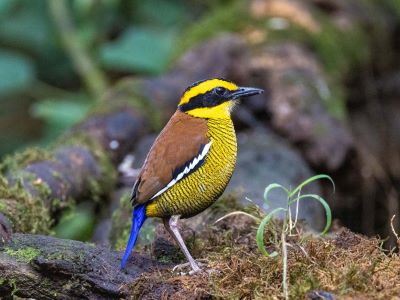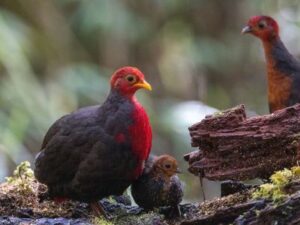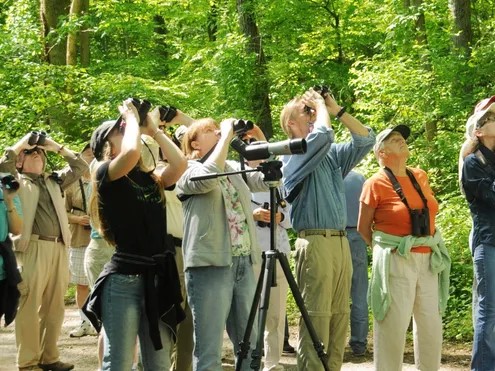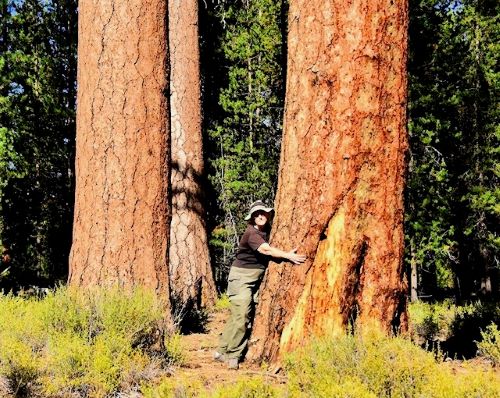The 3rd Saturday Bird Outing on July 20 will be at Clearwater Park in Springfield…

In person at the Campbell Ctr or to join Zoom Meeting:
https://uoregon.zoom.us/j/
Meeting ID: 944 3256 4392 Passcode: 546217
In April of 2023, Magnus Persmark and his wife, Rosie Hammond, joined a small group led by a local guide, that explored the Malaysian part of Borneo for several weeks. Although focused on birds, Magnus will share some of their overall experiences there in this presentation.
 Borneo, the third largest island in the world, straddles the equator. From the alpine meadows of Mount Kinabalu, at 13,400 feet the highest point between New Guinea and the Himalayas, montane rainforests fan out towards the lowlands. Here they meet peaty swamps, mangrove flats, and a lowland rainforest dominated by dipterocarps, a tree family with a center of diversity in Borneo, but also found in the tropics around the globe.
Borneo, the third largest island in the world, straddles the equator. From the alpine meadows of Mount Kinabalu, at 13,400 feet the highest point between New Guinea and the Himalayas, montane rainforests fan out towards the lowlands. Here they meet peaty swamps, mangrove flats, and a lowland rainforest dominated by dipterocarps, a tree family with a center of diversity in Borneo, but also found in the tropics around the globe.
 This lowland rainforest formed around 140 million years ago, making it the second oldest on Earth after Australia’s Daintree. With 3,000 tree species plus 12,000 plants that include orchids, pitcher plants, and the remarkable Rafflesia, these forests are astoundingly rich in fauna. Only the Amazon basin supports more species. This is in part due to the island having repeatedly become part of, then separated from, other parts of Southeast Asia over geological time. The unique biotopes include “sky islands” along the mountainous spine that are home to several very restricted and endemic plant and animal species.
This lowland rainforest formed around 140 million years ago, making it the second oldest on Earth after Australia’s Daintree. With 3,000 tree species plus 12,000 plants that include orchids, pitcher plants, and the remarkable Rafflesia, these forests are astoundingly rich in fauna. Only the Amazon basin supports more species. This is in part due to the island having repeatedly become part of, then separated from, other parts of Southeast Asia over geological time. The unique biotopes include “sky islands” along the mountainous spine that are home to several very restricted and endemic plant and animal species.
However, the greatest floral and faunal diversity is found in the lowland rain forests. Due to infertile soils, these vast forests remained inhabited by only small numbers of tribes known for head-hunting, along with such charismatic mammals as the Orangutan, Borneo Pygmy Elephant, Sumatran Rhino, Proboscis Monkey, and Cloud Leopard.
 Together with numerous smaller, nocturnal, strange, and little-known creatures like Flying Foxes, Civet Cats, Slow Lories, strikingly plumaged birds, electric-colored butterflies, and huge beetles, Borneo has long intrigued naturalists. Arguably the most notable is Russell Alfred Wallace, an English naturalist, explorer, geographer, anthropologist, biologist, and illustrator whose formulation of the theory of evolution and natural selection predated Charles Darwin’s more famous published contributions.
Together with numerous smaller, nocturnal, strange, and little-known creatures like Flying Foxes, Civet Cats, Slow Lories, strikingly plumaged birds, electric-colored butterflies, and huge beetles, Borneo has long intrigued naturalists. Arguably the most notable is Russell Alfred Wallace, an English naturalist, explorer, geographer, anthropologist, biologist, and illustrator whose formulation of the theory of evolution and natural selection predated Charles Darwin’s more famous published contributions.
 While huge tracts of virgin forests have been felled over the last half-century for lumber and conversion to oil palm plantations, it is still possible to find undisturbed tracts of primeval forests. For birders, the nearly 60 endemic species hold particular interest. They include one monotypic endemic family, the Bristlehead, plus birds both odd (Dulit Frogmouth, Bornean Ground-cuckoo, and Bare-headed Laughingthrush) and striking (Bulwer’s Pheasant, Whitehead’s Trogon, Hose’s Broadbill, and Bornean Banded Pitta). Borneo is also home to a range of other Southeast Asian species like hornbills, trogons, kingfishers, barbets, woodpeckers, flycatchers, bulbuls, babblers, flowerpeckers, and sunbirds.
While huge tracts of virgin forests have been felled over the last half-century for lumber and conversion to oil palm plantations, it is still possible to find undisturbed tracts of primeval forests. For birders, the nearly 60 endemic species hold particular interest. They include one monotypic endemic family, the Bristlehead, plus birds both odd (Dulit Frogmouth, Bornean Ground-cuckoo, and Bare-headed Laughingthrush) and striking (Bulwer’s Pheasant, Whitehead’s Trogon, Hose’s Broadbill, and Bornean Banded Pitta). Borneo is also home to a range of other Southeast Asian species like hornbills, trogons, kingfishers, barbets, woodpeckers, flycatchers, bulbuls, babblers, flowerpeckers, and sunbirds.
Magnus was born in Gothenburg, Sweden, and spent much time outdoors; the ancient Swedish law of common access to private lands made it easy and safe for kids to roam. Birds captured a particular interest and continue to fascinate. Magnus moved to the US in the late ‘80s to pursue biochemistry graduate work. He and his wife have enjoyed living and birding in Eugene since 2005.
This LCAS program meeting will be at 7pm on Zoom and in person at the Campbell Center, 155 High St, Eugene, 97401 + Google Map
For the Zoom link, check back closer to the date.



